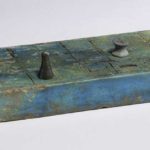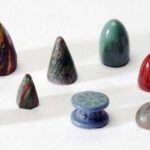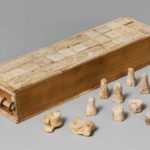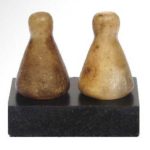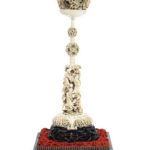Senet is the oldest known board game. Fragmentary boards that could be senet have been found in First Dynasty burials in Egypt, c. 3100 BCE. The first unequivocal painting of this ancient game is from the Third Dynasty tomb of Hesy (c. 2686–2613 BCE). People are depicted playing senet in a painting in the tomb of Rashepes, as well as from other tombs of the Fifth and Sixth Dynasties (c. 2500 BCE). The oldest intact senet boards date to the Middle Kingdom, but graffiti on Fifth and Sixth Dynasty monuments could date as early as the Old Kingdom. Reference: Wikipedia
Below are some examples and price guides of Senet games including a faience board and a group of Ancient Egyptian gaming pieces.
Egyptians enjoyed playing board games, especially senet, or “passing.” During the 18th dynasty, the game acquired religious significance, which transformed it into a simulation of the soul’s journey through the underworld to achieve immortality. Throw sticks, much like dice, determined a player’s moves, and winning required both skill and luck. This senet game board of 30 squares required 14 game pieces, like these spool- and cone-shaped pieces.
Reference: The Walters Art Museum
A circular pottery platter, reconstructed from four fragments with two small parts missing. The central part of the upper surface is scored with a pattern of lines in a grid-pattern of 10 x 3 squares, for use as a game-board. This pattern was incised after firing. The platter is made from a low-fired red-brown siltware fabric containing sand and grit temper. The surface was covered by a pale cream slip, which has worn off in places. The edge of the platter is rounded and the underside is uneven. Number and distribution of squares suggest that the object is a board for the traditional Egyptian senet-game.
Reference: © The Trustees of the British Museum
Group of Ancient Egyptian Senet Gaming Pieces
Egypt; A diverse group of 11 mainly glass pieces, but including red jasper and faience. Some faceted, one iridescent. Especially notable are a spool form bi-color faience example and a hemispheric piece with a painted depiction of a jackal on top. A wonderful group, very rare.
Sold for $1,600 at Associated Estate & Appraisal Co., Inc. in 2018
Game Box for Playing Senet and Twenty Squares ca. 1635–1458 B.C.
The upper and lower surfaces of this box are each configured for a different board game. The side visible in this photograph has twenty squares for a game that was introduced into Egypt from the Ancient Near East. The other side has thirty squares for the Egyptian game known as Senet. These were both games in which two players raced each other for position, using knucklebones or throw sticks as dice to determine each play. For this game box, eight of the original gaming pieces and two bones are preserved. The pieces would have been stored in a drawer that could be closed with an ivory bolt.
Reference: The Metropolitan Museum of Art
Game pieces Egyptian New Kingdom, early Dynasty 181539–1458 B.C.
Game pieces, seven of conical shape with ball tops and four of spool type, for Senet. Faïence and wood
Reference: Museum of Fine Arts Boston
Two Egyptian Alabaster SENET Gaming Pieces, c. 18th Dynasty, Amarna Period, c. 1361-1352 B.C Conical shape with pointed knob at the top.
Sold for $420 at Artemission in 2016
